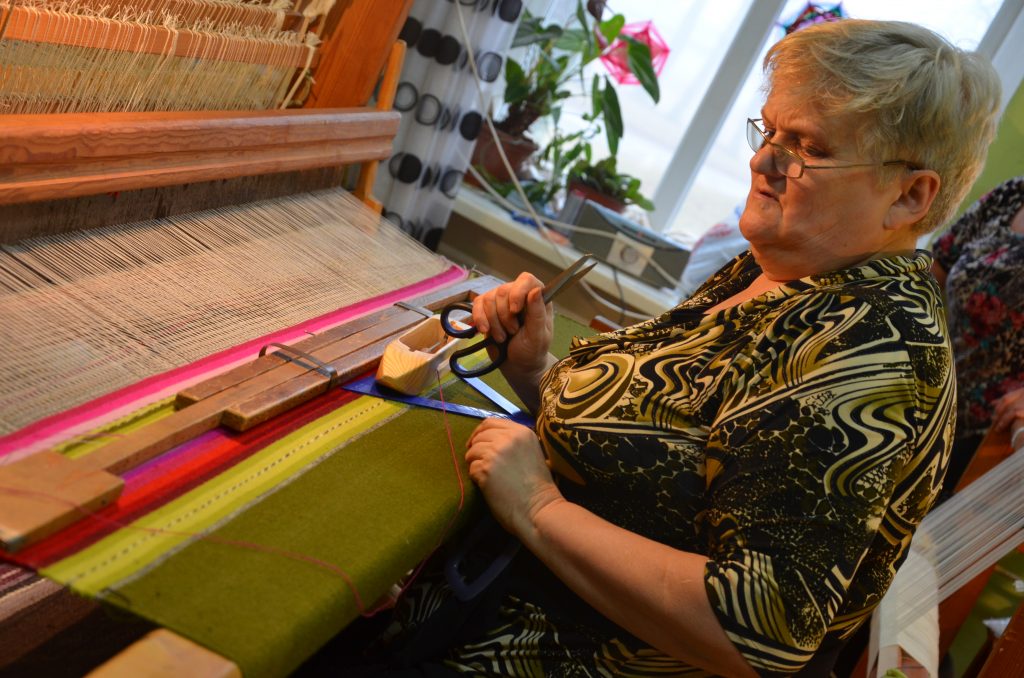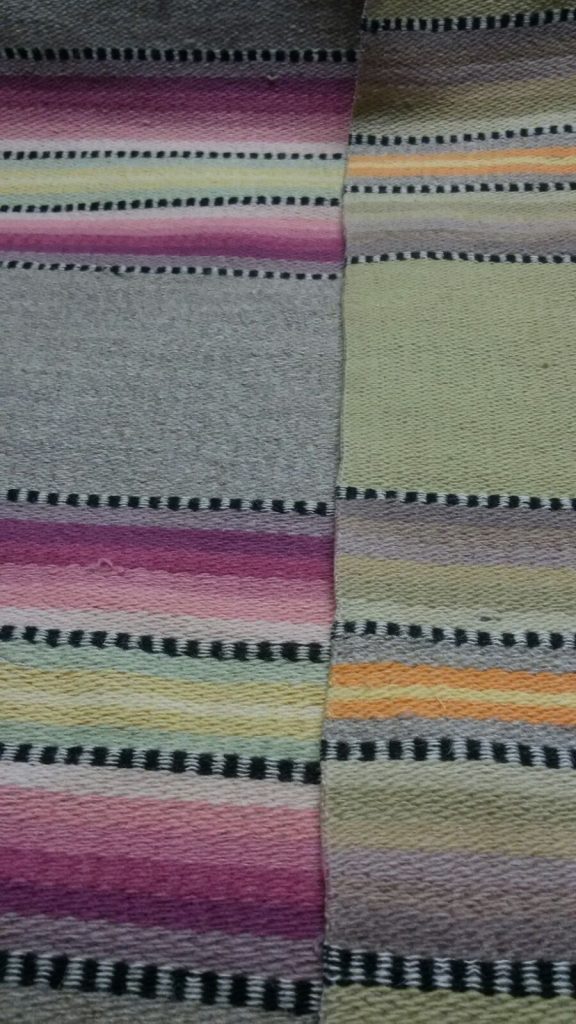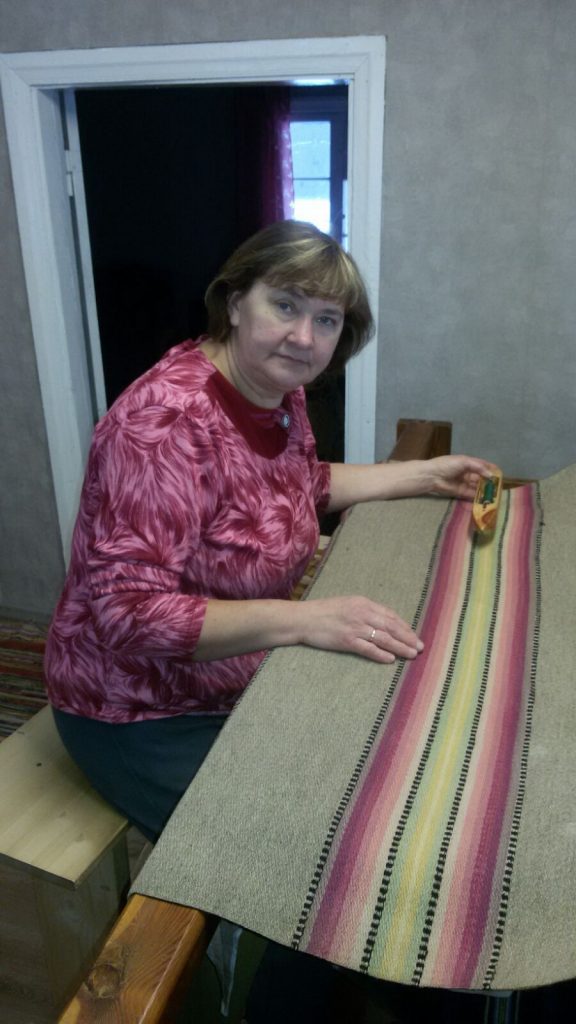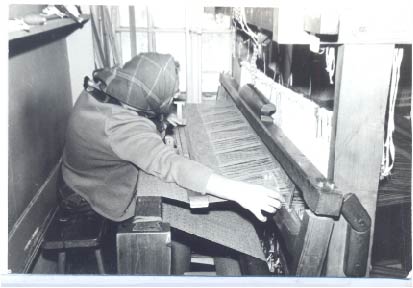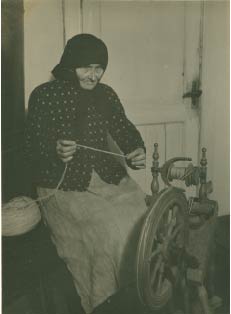Author:
Aivars Ikšelis
Traditional craft skills
Knowledge and practices concerning nature and the universe
Title
Doubleweave colour gradient blanket weaving in Northern Vidzeme (2018)
Doubleweave colour gradient blankets — Valka, Smiltene, Kārķi and Vijciems parishes.
From Estonian to weave “topelt tekku” (doublework, “to do double work” or to “weave a doubleblanket”).
Also called a “dubultīgais šatiera deķēns” in Ērģeme.
Geography
Northern Vidzeme
There are several groups with connections to the Element. These include:
1. Passive tradition bearers or individuals who do not weave doubleweave gradient blankets themselves but belong to this community and are able to identify them and appreciate the skill involved. In childhood, they often had a relative who wove these kinds of blankets or had seen someone do this kind of weaving.
2. Members of the community who own doubleweave gradient blankets woven by a relative and consider them proof of weaving mastery. This group also includes individuals who had earlier woven such blankets themselves and acquired skills from family members, members of weaving groups, or Folk Art Masters.
3. Weavers of varying ages who learned to weave doubleweave gradient blankets on their own through weaving groups or through the Folk Art Studio “Saulīte” and “Smiltene” workshops, which has resulted in the fomation of a small weaving community in northern Vidzeme where member exchange notes on their weaving experiences and introduce the public to their work through exhibitions.
Significance in community life
The weaving of doubleweave blankets or doubleweave gradient blankets (with bands of several transitional colour) has been a characteristic of weaving in northern Vidzeme since the nineteenth century.
Early in the twentieth century, this weaving community paid particular attention to making articles of a decorative nature.
The weaving of doubleweave gradient blankets reached its zenith in the 1990s.
Valka weaver Milda Eglīte (1926–2015) writes in her 1875 memoir: “On the one hand, the weaving of ‘topelt tekks’ is comfortable – you don’t have to strain as you shoot the shuttle through the shed – it is only about 80 centimetres. On the other hand, you do not see what is happening on the underside of the fabric. The transition from one colour to another is particularly problematic. Overcoming this difficulty requires exceptional mastery.”
The weaving of doubleweave gradient blankets in northern Vidzeme has started to decline for economic reasons although it has not lost its meaning among weavers. The largest collection of doubleweave gradient blankets can be found in the Ethnographic Open-Air Museum, the Valka Local History Museum, and in a few private collections in northern Vidzeme. These blankets show how age-old traditions have persisted and how change has come into play.
Today, the synthesis of old and new tradition demonstrates the importance to the community of this blanket which reflects the national uniqueness of this woven blanket and its traditional characteristics.
Activities
Countermarch looms were used for home weaving as many types of these looms could be found in farm houses. The looms were between 160 and 200 centimetres wide.
Doubleweave gradient blankets are thick, stiff, reversible (there is a different arrangement of stripes on each side), and functional striped wool blankets. Traditionally, weavers in northern Vidzeme made such blankets in the winter months.
The colour combinations found in blankets are usually inspired by nature. Yarns were dyed using plant dyes until the second half of the nineteenth century.
In 1974, Folk Art Master, longtime director of the Folk Art Studio “Saulīte” Brunhilde Pētersone (1923–2005) visited Valka district weavers (in Bilska, Ēvele, Cirgaļu [Zvārtava], and Smiltene parishes) and took notes of their colour choices and realized the poetry and symbolism behind these choices.
Brunhilde Pētersone wrote: “The influence of the Gauja, Vija, and Abuls rivers can be felt in the blankets of Vijciems and Trikāta parish doubleweave blankets.”
Examination of doubleweave blankets in museum collections shows that there were seven basic colours.
The work of Blome parish weavers contain the colours typical of central Vidzeme. A significant amount of Estonian influence can be seen in the colours of blankets woven in Valka, Omuļi, and Ērģeme parishes. The colours favoured by weavers in Karksi-Nuia in Estonia are reflected in the work of weavers in Naukšēni.
Passing on and transferring skills
Each weaver in northern Vidzeme has their own signature style, which has come into being through inherited knowledge, practice, and their own creative process. The weaving of these blankets has declined significantly although a few young weavers are working on mastering this craft, learning to dye yarn and the principles of colour composition.
Members of the Folk Art Studio “Saulīte” and the weaving groups in Vijciems, Kārķi, and Ērģeme weave, knit, crochet, and make bobbin lace (a very complex ancient type of lace making). These groups attract people who create beauty for themselves and others.
The mission of the Folk Art Studio “Saulīte” is to promote interest in learning, safeguarding, and promoting the cultural heritage of northern Vidzeme bringing together various generations and social groups.
Here woven doubleweave colour gradient blankets are a part of Latvian culture that is founded in traditional cultural heritage.
To prevent the tradition of weaving doubleweave gradient blankets from being lost, the Folk Art Studio “Saulīte” dedicates special attention to this craft. These weavers are to be commended for their desire to pass their skills on to the younger generation in addition to their focus on the study of weaving techniques, documentation, and the safeguarding of practical skills.
History
In 1695, the Viru-Jaagupi clergyman and historian Christian Kelch noted that Latvians covered their beds with a coarse linen sheet or wool blanket. Kelch’s account does not include a reference to doubleweave gradient blankets – only to wool blankets.
Up until the end of the nineteenth century, peasant homes were small, dark, and dull and blankets dyed in natural colours enlivened their interiors.
Older blankets, like skirt fabrics, consisted for narrow stripes.
In the mid-nineteenth century, the stripes began to be arranged in wider groupings and each weaver would arrange them according to their own aesthetic sense.
Beginning the 1880s, colour gradients made their appearance in peasant textiles, i.e. the gradually blending of one colour into another.
Grey is the foundational colour of doubleweave blankets in northern Vidzeme. A band of colour consists of four colour stripes with a black line marking its beginning and end. In the middle, there is a progression from sand to dark brown over five different shades. The width of a stripe is variable. Cotton is usually used for the warp while wool is used for the weft. During this period, the weaving of blankets passed into the hands of professional weavers and a definite stripe pattern emerged in the composition of the blanket, which made use of four to six stripes grouped together on a grey background. As weaving skills developed and looms increased in size, this weaving technique produced a thick fabric with two interconnected layers and different colour combinations on either side. This happens by joining the two fabric layers together in both the warp and weft.
In the twentieth century, these blankets became popular throughout northern Vidzeme.
Ethnographer Aina Alsupe (Emeritus Researcher, Ethnography Department in the History Institute at the Latvian Academy of Sciences, Doctor of History) wrote in her 1982 book “Audēji Vidzemē 19. gs. otrajā pusē un 20. gs. sākumā” [Weavers in Vidzeme in the Second Half of the Nineteenth Century and Early Twentieth Century]: “Early in the twentieth century, the master weavers of Rauna were rich in initiative. They developed a new type of heavy blanket for cold weater—an especially strong type of doubleweave that looked like two interconnected blankets with different colours and patterns. In Smiltene, master weavers who were graduates of P. Viļumsons’ courses disseminated an unusually strong blanket with a colourful top layer and a white bottom layer.”
The many types of patterns and wealth of colours found in doubleweave gradient blankets attests to the weaving skills of our applied arts masters.
The blankets made of natural materials continue to grow in popularity because they bring comfort and coziness to home interiors.
Unfortunately, not everyone can afford a blanket this expensive even though it is seen as a valuable gift. It can serve as an important aspect of interiors and sometimes as a luxury item because its practical application is not longer as important.
Additional Information
Dying yarn with plant dyes is a creative process that brings new experiences as well as ideas for future work.
There are so many natural resources for dying that one could spend their entire life experimenting. There also are no strict rules for achieving specific colours. Both the location and timing of plant collecting can bring surprises.
Colours gained from grasses that grew coastal sands will be different from those grown in more fertile soil. Fresh plants will give brighter shades while dried plants yield paler shades.
The type of water used for dying is no less important – you will never get the same colour by dissolving the identical amount of dyestuff in tap water, well water, rain water or melted snow. It is harder to dye yarn in water that is high in lime or iron than in soft rain or lake water or melted snow. For this reason, it is advisble to boil water before dying and strain off any sediment. All parts of a plant can be used for dying yarn. It is true, though, that those higher in tannins such as roots and skins yield brighter shades and will be more resistant to fading in sunlight.
Our ancestral knowledge about the impact of lunar cycles on plant collection and yarn dying is also important.
To ensure the weaving proceeds smoothly, it is not advisable to begin weaving doubleweave gradient blankets on Mondays.
Masters
Doubleweave gradient blanket weaving masters:
• Astrīda Bērziņa (b. 1940);
• Anna Gaile (b. 1941);
• Ārija Lozda (b. 1943);
• Ārija Tomiņa (b. 1945);
• Irēna Galgāne (b. 1948);
• Inese Pētersone (b. 1957);
• Mārīte Kalniņa (b. 1960);
• Aivars Ikšelis (b. 1961);
• Līvija Kreile (b. 1964);
• Baiba Tīlēna (b. 1965);
• Guna Ikšele (b. 1968);
• Anita Āboliņa (b. 1969).
Agencies and institutions
• Valka Municipality Education, Culture, Sports and Youth Department;
• Valka Cultural centre;
• Folk Art Studio “Saulīte”.
Consolidation
In order to ensure the existence and continuation of the element, in the previous 5 years:
• 2 exhibitions have been held: “Doubleweave colour gradient blanket from museum stores” and “Doubleweave colour gradient blanket Today” (total number of visitors: 284);
• a seminar on compositions of color in Doubleweave colour gradient blanket in Vidzeme (32 participants);
• The activity “Winding yarn in tent colors on rocks” was carried out for preschool children and younger students at Valka J. Cimze Gymnasium, Ērģemes Elementary School and “Pasaciņa” preschool institution in extracurricular classes (63 participants);
• The LNKC exhibition “Saimes galds” dedicated to the values of the Latvian Intangible Cultural Heritage List was implemented in Valka;
• work has begun to collect, record and compile materials for a book about the doubleweave colour gradient blankets and their weaving.
Students of pre-school and younger classes have met the Doubleweave colour gradient blankets of the north Vidzeme. There was a little interest in their weaving, because the activities took place in the weaving rooms of Folk Art Studio “Saulīte”. An interest in the weaving of Vidzeme's doubleweave blanket weaving was also shown by Valka's retired club “Zelta rudens” craftsman band members. He was active in the pre-retirement and retirement age, who had already attended a Folk Art Studio “Saulīte” and familiar with the weaving of the Vidzeme doubleweave blanket weaving. This appointment was directed by Inese Pētersone. Also in previous years, the event “Meet your master” was presented with the tradition and practical weaving of Vidzeme doubles, and took part in the familys from Kārķi, Gaujiena, Vijciems, Rūjiena and Strenči.
Valka Municipality has provided free spaces, exhibitions – stands for placement and payment of artist works for all activities that have been associated with this element. Folk Art Studio “Saulīte” members have provided raw materials for practical activities.
Continuation/development
The promotion of the main activity element in the next 5 years will be linked to the preparation of research and the preparation of monographs for the weaving of dubulouduma shatters in Northern Vidzeme; responsible: Aivars Ikšelis (up to 2027). The staff of the Valka District Research Museum shall be involved in the research work. In particular, samples of the elements in the museum store are evaluated and analysed, as some are from the 19 th century. Their situation is unsatisfactory and needs to be restored.
Planning of new doubleweave colour gradient blanket weaving in Ērģeme (Estonian border) and documentation of masters' works; responsible – Livija Kreile (2023–2027).
The following measures are planned for the protection and development of the element:
• At the annual exhibitions of weavers from TLMS “Saulīte”, Kārķi, Vijciems and Ērģeme, additional information about the importance of this element in Northern Vidzeme will be placed next to the Doubleweave colour gradient blankets; responsible person – Inese Pētersone;
• annually in Valka's municipality, organize an activity “Meet your master”; responsible – Inese Pētersone and Ārija Dzintra Tomiņa (2023–2027);
• weaving of new Doubleweave blanket in Kārķi; responsible – Inese Pētersone (2023–2027);
• weaving of new Doubleweave blanket in Vijciems; responsible – Anita Lotiņa (2023–2027);
• continue working with Valka's primary school and younger classes, learn the weaving of Doubleweave colour gradient blanket in Northern Vidzeme; responsible – Ārija Dzintra Tomiņa (2023–2027);
• Establishment of an exhibition “Doubleweave colour gradient blanket in Vidzeme”; the responsible Folk Art Studio “Saulīte” leader Inese Pētersone and Folk Art Studio “Smiltene” head Liene Strazdiņa (2026).
The objective of these measures is to educate an increasing proportion of the local community about the importance and uniqueness of this element. It is also necessary to explain the threat of this element – the generators are increasingly weaving such blankets because the price of raw materials has increased inadequately due to economic conditions. A dramatic change in the aesthetic sense and values of society, which generally poses a threat to the element.
Threats
Doubleweave gradient blanket weaving traditions in northern Vidzeme are under threat for several reasons:
• There is a shortage of master weavers because the current generation is aging and youth are not interested in pursuing craft work because profit margins are low. The number of individuals inheriting the tradition is declining;
• Weaving doubleweave gradient blankets is very expensive since looms cost between 8,790 and 16,199 euros. One blanket requires approximately 2.5–3.0 kilograms of wool yarn. Today, one kilogram of wool yarn costs 15 to 28 euros. Approximately 400 grams of cotton yarn is needed for the warp (usually in combination with a synthetic fibre). One spool 500 metres in length costs 2–3 euros;
• Demand for doubleweave gradient blankets is low;
• Blankets such as this last several generations, but people today prefer simpler, less expensive, more frequently replaceable items.
Applicant
Valka District Council, Reg. No. 90009114839
Image Gallery
Text Materials
Publications
Kelch C. (1695) Liefländische Historia, oder kurtze Beschreibung der Denkwürdigsten Kriegs - und Friedens-Geschichte Esth -, Lief - und Lettland. – Reval
Kelch C. (2011) Liefländische Historia. Continuation 1690 bis 1707. Mit Vorwort, Nachweisen und Personenregister versehen von J. Lossius, British Library, Historical Print Editions
Alsupe A. (1982) Audēji Vidzemē 19. gs. otrajā pusē un 20. gs. sākumā. Rīga; Zinātne
Alsupe A. (1963) “Auduma veidi Vidzemē” (19. gs. otrā un 20. gs. pirmā puse). Arheoloģija un etnogrāfija : rakstu krājums, V [edition] Rīga
Alsupe, A. (1961) Lauku audēju darba rīki Vidzemē 19. gs. - Arheoloģija un etnogrāfija, III [edition], Rīga
Alsupe, A. (1962) Tekstilijas. Latviešu tautas māksla 19.—20. gs., 2. edition - Rīga

